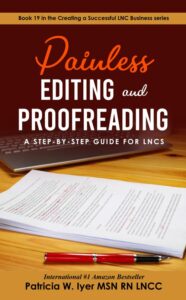LNC Writing Styles and Examples of What to Avoid
LNC writing styles follow the rules of professional writers. LNCs often need clarification about issues of writing style.
Part of developing your writing style involves understanding more general writing styles, so I’ll begin by describing the three most common styles.
Expository Writing
Expository writing doesn’t express an opinion. A news article reports facts. It might quote the opinions of others, often from more than one viewpoint, but the writer doesn’t express his or her opinions. For example, some blog posts explain concepts without expressing opinions.
In my experience, most LNC blog posts focus on facts, picking clinical issues important to attorneys. Blog posts highlight the LNC’s knowledge, thereby serving as a marketing tool.
I advise my coaching clients who serve as experts to know that opposing counsel may find their blogs. Experts should be cautious about making definitive statements about standards of care and avoid absolutes unless they are warranted.
Statements like, “It is always a deviation in the standard of care when a patient falls” or “All pressure ulcers are avoidable” can result in uncomfortable cross-examination. As you edit your blogs, consider how an attorney would react to the content. Is your writing clear, helpful, and devoid of traps, particularly if you are an expert?
Persuasive Writing
An opinion piece is precisely that. It presents the writer’s perspective on an issue. It may appear as an editorial. Opinion writing is also called persuasive writing.
You will most likely use this writing style if you are writing an expert witness report. You want to convince your client and opposing counsel of the soundness of your opinions.
However, to make your viewpoint convincing, you will need to cite facts, standards, and other forms of evidence. Make sure that any factual claims you make can be verified. This makes you credible and trustworthy.
Narrative Writing
This form tells a story. Consider how you would blend facts and opinions in a blog, but they are subordinate to the main purpose of storytelling. A narrative uses characters, conflict, and settings.
Narrative writing gives you another opportunity to express your unique style of writing. The stories you choose to tell and how you tell them will express who you are.
Regardless of your writing length, you will probably use more than one of these styles. Your challenge will be to blend them together. Don’t go directly from a story to a recitation of facts or statistics. Make a transition. Look for ways to do that when you edit.
Just as a good cook finds new ways to blend ingredients, you can blend the major writing styles into a result that keeps your readers satisfied.
Develop Your Unique Writing Style
Avoid cliches.
Anyone can rattle out a catchphrase. Not only will they bore your reader, but they have a short shelf life and will date your writing.
Choose Your Stories.
I’ve said this before, but it bears repeating. Nothing makes your writing more unique than your experiences.
Take Risks.
Too many writers, especially new ones, censor themselves. They think, “That’s too personal. I don’t want anyone to know that.”
Sometimes they’re right, and you must always consider the issue of Too Much Information. You’re trying to reach people who have had similar experiences, and they want to identify with you. This is how we connect.
Read.
I’m always astonished when I hear someone who wants to write say they never read. Read widely and thoughtfully. Notice what makes the author’s voice unique.
Be careful when you write that you don’t adopt another writer’s style. You don’t want to be an imitation of Margaret Atwood or Stephen King. Write as your own best self.
Journal Regularly.
Ideally, you capture your thoughts daily as a goal, but begin with what you can comfortably do, and journal more frequently as you become more comfortable. This not only gives you writing practice, but it will also help you develop ease in expressing your feelings.
Words and Phrases to Eliminate from Your Vocabulary
Here’s how to improve your writing style. Pa careful attention to your word choice. Some words are meaningless; some are fillers. Consider these offenders.
Truth Be Told
Weak
Truth be told , I wasn’t sure what to do next.
Stronger
I struggled over what to do next.
The second sentence includes a strong, active verb.
I was delighted to read on several grammar sites that this phrase is considered old-fashioned and obsolete. Ironically, it seems to be getting increasingly popular. I’ve seen it in novels by authors who otherwise write well, and it stops me every time. It’s just as intrusive in nonfiction.
You never need to point out that you’re writing the truth. It’s a mistake to do so.
Also, you begin a sentence passively when you use this phrase. Truth be told, you don’t need it.
This is a weak sentence
“In the end, they agreed that discarding the expensive contaminated medical equipment was the only choice for them.”
This sentence is stronger
“They discussed whether discarding the expensive, contaminated equipment was the only choice.”
There are
This phrase tempts me a lot, and occasionally I use it, but I keep it to a minimum. It’s another lazy phrase. It’s an easy way to lead into a sentence, but it’s another filler phrase. It employs a passive voice and the deceptive “there,” which should usually refer to a location.
Weak
“There are many ways to begin a sentence.”
Stronger
“Use several catchy phrases to begin a sentence.”
Starting to / Beginning to
For a long time, I used both phrases unquestioningly. I finally realized that they both had a tentative quality. Why am I starting, for example, to question the value of these phrases? I’m not starting; I’m questioning. Eliminating “starting” and “beginning” gives a complete feeling to a statement.
For All Intensive Purposes
I’ll end with an inaccurate phrase. Someone may have intensive purposes, but they have nothing to do with this phrase.

The correct usage is “for all intents and purposes.” While we’re on the subject, though, I don’t recommend using this phrase either. What does it mean? Nothing. It’s another filler phrase that has snuck into the language. Let it sneak out.
Get additional tips for streamlining your writing by investing in my new book, Painless Editing, and Proofreading: A Step-By-Step Guide for LNCs Find it at http://LNC.tips/creatingseries

Pat Iyer is president of The Pat Iyer Group, which develops resources to assist LNCs in obtaining more clients, making more money, and achieving their business goals and dreams.
Pat’s related websites include the continuing education provided on LNCEU.com, the podcasts broadcast at podcast.legalnursebusiness.com, and writing tips supplied at patiyer.com.
Get all of Pat’s content in one place by downloading the mobile app, Expert Edu at www.legalnursebusiness.com/expertedu. Watch videos, listen to podcasts, read blogs, watch online courses and training, and more.


